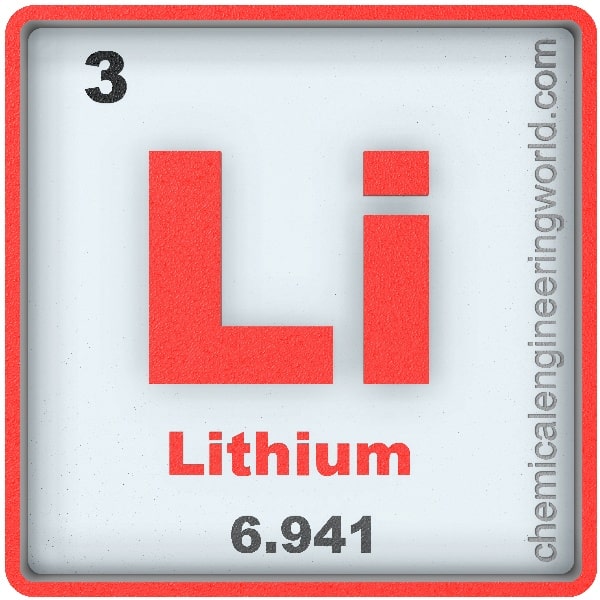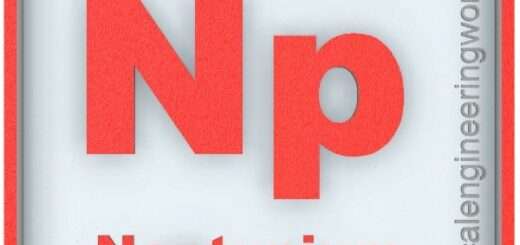Lithium Element Properties and Information

Lithium Element Properties and Information
Lithium is the third element in the periodic table. Elements are arranged in the periodic table on the basis of atomic number. Atomic number is the number of protons in the nucleus of the atom. Lithium has an atomic number of 3. It is located in the Group 1 and Period 2 of the periodic table of elements. It is denoted by Li. The name is derived from Greek word ‘Lithios’ which means stone.
A mineral named petalite was observed to give an intense crimson flame when it was thrown into fire. Johan August Arfvedson analysed petalite in 1817 and deduced that it contains a metal which was unknown at that time, it was an alkali metal like sodium but it was relatively lighter. He was not able to separate the metal from the mineral. In 1821 William Brande was able to separate a tiny amount of lithium by electrolysis in the same way he obtained sodium, but he was not able to obtain enough amount in order to make measurements on the sample. Robert Bunsen and Augustus Matthiessen produced lithium in bulk by electrolysis of molten lithium chloride.
Although lithium is a light element it is relatively less common than the 25 of the first 32 elements on the periodic table. It is because lithium is a highly active metal, usually it is present in combined form. Lithium is moderately abundant on planet earth. It’s concentration is 65 ppm in Earth’s crust. It is found in almost all igneous rocks and in the waters of many mineral springs.
Physical Properties
- It is a soft and silvery metal which is white in appearance.
- The atomic mass of lithium is 6.941
- The melting point of lithium is 180.5°C
- The boiling point of lithium is 1342°C
- The density of lithium is 534 in S.I. units.
- It has the lowest density among all the metals.
- Only two among all the isotopes of lithium exists in stable form in nature.
- At temperatures below 70K lithium undergones diffusionless phase change transformation.
Chemical Properties
- Lithium is flammable and highly reactive. It has to be stored in a hydrocarbon sealant. Commonly petroleum jelly is used.
- When lithium is cut it displays a metallic luster. If moisture is present in air then it will corrode the cut lithium and rapidly turn it into a dull silvery grey colour indicating formation of lithium oxide. Further exposure tarnishes the surface and turns it to black.
- Lithium is insoluble in hydrocarbons while it is soluble in short chain aliphatic amines.
- Lithium reacts with oxygen to form oxides and peroxides.
- Lithium is the only alkali metal which reacts with nitrogen to form a chemical compound at ambient temperature. The name of the compound is nitrure.
- Lithium reacts with halogens to form halogenures, it reacts with carbon to form carbure, it reacts with acetylene to form lithium acetylures.
- Lithium reacts with hydrogen to form lithium hydrides at 500°C.
- Lithium reacts with water to form hydrogen gas and an aqueous solution. The aqueous solution contains lithium hydroxides.
- A compound of lithium and helium has also been detected at low temperatures. LiHe is a low density gas and the nature of interaction is a very week vanderwaal force.
Methods of Production
- Electrolysis: This is the most common method used to produce the metal. Lithium is produced by electrolysis of fused mixture of lithium chloride and potassium chloride at 450°C. The concentrations in the fused mixture are such that 55% is lithium chloride and rest of the 45% is potassium chloride.
- Filtration: Geothermal mineral waters are a good source of lithium, hence the waters are pumped from the geothermal reservoirs to the surface and then they are filtered to separate lithium.
Relevance in Chemical and Related Industries
- In Soap and Grease Industries: Soaps made of Lithium has the property to thicken oils and these soaps are used to manufacture high temperature, all purpose lubricating grease. Lithium hydroxide is heated with fat to make a soap called lithium stearate.
- In Metallurgical Industries: Lithium fluoride is used as an additive to aluminium smelters in order to reduce the melting temperature and electrical resistance. Lithium carbonate is used to increase fluidity in continuous casting flux slags.
- For Air Purification: Lithium hydroxide is often used to purify air in the confined spaces. They react with carbon dioxide in air to form lithium carbonate. Lithium chloride and lithium bromide are hygroscopic hence they are used as desiccants for gas streams. Lithium peroxide reacts with carbon dioxide results in oxygen as a byproduct.
- In Polymer Industries: Alkyl lithium compounds are used as catalysts and initiators in polymer industries, they are the largest consumers of such organolithium compounds. They are used in anionic polymerization of unfunctionalized olefins.
Relevance in Other Industries
- In Glass and Ceramic Industries: The melting point and viscosity of the silica is reduced by adding lithium oxide as a flux. This results in glazes which has low coefficient of thermal expansion and has improved physical properties. These glazes are also used to make ovenwares.
- In electrical and electronics industries: Lithium has low atomic mass, high electrode potential, high charge to weight ratio, and high power to weight ratio. Due to these characteristics lithium ion batteries became quite popular. There are rechargeable batteries as well as disposable batteries.
- In Optic industries: Lithium fluoride can be grown as crystals and ensured to be clear and transparent. It has one of the lowest refractive indexes compared to other materials. It is used for optics in Ultraviolet (UV), Infrared (IR) and Vacuum ultraviolet (VUV) applications.
- In Nuclear Industries: When lithium fluoride is enriched with lithium-7 isotope then they form the basic constituent in the fluoride salt mixture which is used in liquid fluoride nuclear reactors. The constituents of the fluoride salt mixture are one of the few nuclides with low enough thermal neutron capture cross section not to poison the fission reactions.
- In Medicine: Lithium is used in medicinal drugs for the treatment of bipolar disorder, clinical depression and schizoaffective disorders.
Health Effects on Exposure
- Burning: Many chemical reactions related to lithium may result in fire or explosion of not properly handled. If personals are not careful enough then they may get hurt.
- Inhalation: It causes shortness of breath, cough, laboured breathing, burning sensations and sore throat.
- Contact: Contact of lithium with eyes causes redness, pain and severe deep burns.
Effects on Surroundings
- Flammable: If the temperature of the lithium metal is increased then the concentration will increase in air. It is very reactive and very flammable. Improper handling of chemical reaction may even result in explosion leading to loss of lives and properties.
- Toxicity: Upon heating lithium fumes are formed which are very toxic to living beings.
- Potential Hazard: Improper disposal of lithium poses potential environmental hazard because lithium reacts with moisture, nitrogen and oxygen in air to form lithium hydroxide, lithium nitride and lithium carbonate on the surface of the metal. It becomes extremely corrosive hence can affect the surroundings and anyone who comes in contact with the metal.
References: Lithium Element
































